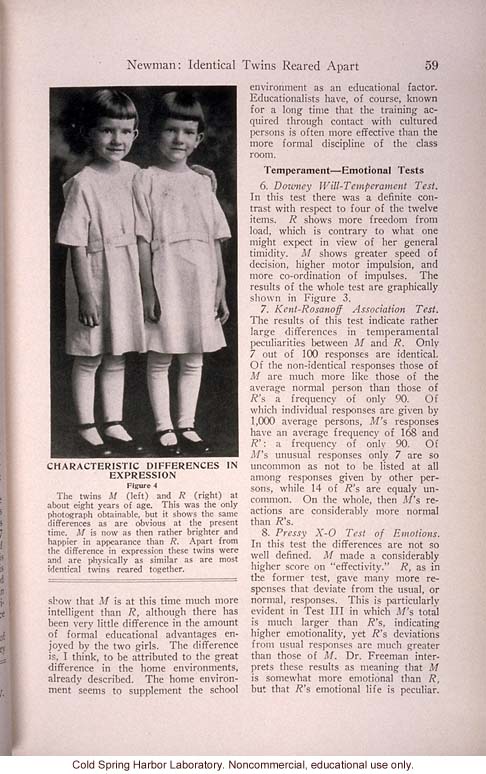Newman: Identical Twins Reared Apart 59
[photo of girls]
Characteristic Differences in Expression
Figure 4
The twins M (left) and R (right) at about eight years of age. This was the only photograph obtainable, but it shows the same differences as are obvious at the present time. M is now as then rather brighter and happier in appearance than R. Apart from the difference in expression these twins were and are physically as similar as are most identical twins reared together.
[double hairline score, column width]
show that M is at this time much more intelligent than R, although there has been very little difference in the amount of formal educational advantages enjoyed by the two girls. The difference is, I think, to be attributed to the great difference in the home environments, already described. The home environments seems to supplement the school environment as an educational factor. Educationalists have, of course, known for a long time that the training acquired through contact with cultured persons is often more effective than the more formal discipline of the class room.
Temperament - Emotional Tests
6. Downey Will-Temperament Test. In this test there was a definite contrast with respect to four of the twelve items. R show more freedom from load, which is contrary to what one might expect in view of her general timidity. M shows greater speed of decision, higher motor impulsion, and more co-ordination of impulses. The results of the whole test are graphically shown in Figure 3.
7. Kent-Rosanoll Association Test. The results of this test indicate rather large differences in temperamental peculiarities between M and R. Only 7 out of 100 responses are identical. Of the non-identical responses those of M are much more like those of the average normal person than those of R's a frequency of only 90. Of which individual responses are given by 1,000 average persons, M's responses have an average frequency of 168 and R's a frequency of only 90. Of M's unusual responses only 7 are so uncommon as not to be listed at all among responses given by other persons, while 14 of R's are equaly[sic] uncommon. On the whole, then M's reactions are considerably more normal than R's.
8. Pressy X-O Test of Emotions. In this test the differences are not so well defined. M made a considerably higher score on "effectivity." R, as in the former test, gave many more responses that deviate from the usual, or normal, responses. This is particularly evident in Test III in which M's total is much larger than R's, indicating higher emotionality, yet R's deviations from usual responses are much greater than those of M. Dr. Freeman interprets these results as meaning that M is somewhat more emotional than R, but that R's emotional life is peculiar.
[end]


